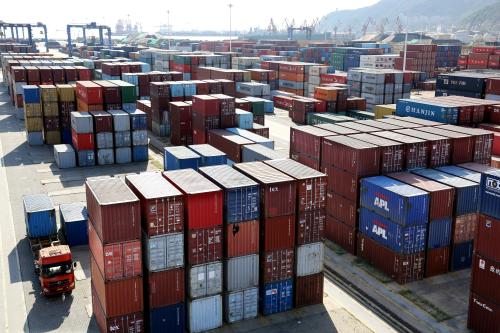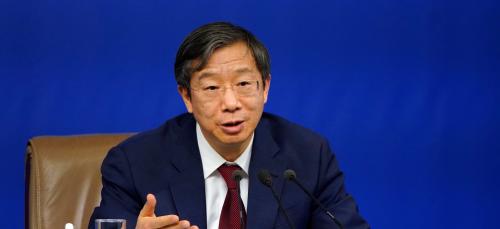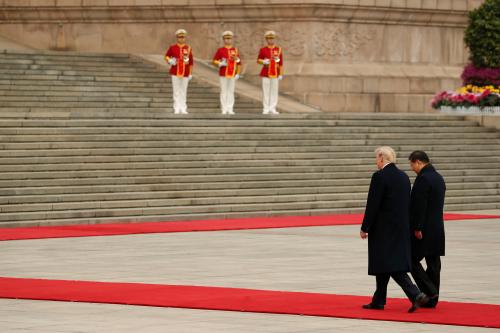President Trump’s expected move to direct the U.S. Trade Representative to open a 301 investigation into China’s violation of U.S. intellectual property rights—especially through forced technology transfer—signals a tougher trade stance, write David Dollar and Ryan Hass. But it’s not yet clear how serious U.S. actions will be. This piece originally appeared on Fortune.
President Trump is expected to direct the U.S. Trade Representative to open a 301 investigation into China’s violation of U.S. intellectual property rights, especially through forced technology transfer. This signals a tougher trade stance on the part of the administration, but it will be some months before it is clear how serious U.S. actions will be.
High-tech U.S. companies cannot currently do business in China unless they form joint ventures with local partners and turn over key technology to those partners. In sectors such as cloud computing, Chinese law also prevents the use of the foreign brand name, which would put U.S. firms at a disadvantage in the future if China ever does open up. American companies agree to these technology transfers because it’s the only way they can access the second-largest market in the world, rapidly on its way to number 1.
The list of companies operating in such ventures is essentially the roll call of top American technology firms. Intel has agreements with two Chinese chipmakers in order to get access to the market for smart phones and tablets. IBM and Advanced Micro Devices have both licensed chip technology to Chinese partners. Qualcomm has a similar partnership. Automakers have to share their technology with local partners in order to produce and sell there.
Companies that agree to operate through these joint ventures are basically betting that they can invent new technologies faster than the Chinese partners can appropriate the existing technology; otherwise, they are partnering themselves out of existence. From China’s point of view, these technology transfers are part of an industrial policy, “Made in China 2025,” aimed at making the country the technology leader in 10 priority sectors: new advanced information technology; automated machine tools and robotics; aerospace and aeronautical equipment; maritime equipment and high-tech shipping; modern rail transport equipment; new-energy vehicles and equipment; power equipment; agricultural equipment; new materials; and biopharma and advanced medical products. These sectors will be supported by financing from state-owned institutions and protected from open competition.
The U.S. faces a number of challenges in taking on these industrial policies. For one, the Chinese restrictions on import of services and inward investment are mostly legal under its World Trade Organization (WTO) accession agreement. When the Clinton and Bush administrations negotiated China’s entry into the WTO, they left the country wide latitude to restrict trade in services and inward investment. The expectation was that China would gradually liberalize these areas over time. The U.S. thought that joining the WTO was the beginning of China’s opening, but it turned out to be the end. There has been no significant opening of these areas since accession in 2001. President Xi Jinping, in particular, seems very wedded to the industrial policies and the China 2025 goals.
By launching the 301 investigation, the U.S. is signaling that it will take a unilateral approach to dealing with China’s behavior. The investigation is likely to determine that China is pursuing unfair trade practices. The dilemma, then, is what to do about it.
The U.S. has been negotiating with China on similar issues for years, and it is unlikely that China will change course easily. The Chinese economy is not as export-dependent as before, and not that U.S.-dependent. China’s exports to the U.S. are about 5 percent of its GDP, but the value added in the exports is more like 3 percent because China’s exports have a lot of imported content from Japan, South Korea, and Taiwan. A serious trade war would be a problem for China, but not such a great one that China is likely to buckle to under pressure. The fact that the Chinese delegation to the Comprehensive Economic Dialogue in July came with so little to offer suggests that the leadership is resigned to poorer economic relations with the United States. Standing firm in negotiation and punching back against any U.S. punitive measures will be better for Xi Jinping politically in the next few years. Historically, China has always responded to trade measures with proportionate retaliation.
Even if China is not likely to change its behavior, the U.S. may proceed with punitive tariffs—section 301 gives the president broad authority to respond to unfair trade practices. The problem here is that anything small, such as tariffs on just a few items, is just symbolic, and anything large will be disruptive to the U.S. and world economies. Given modern value chains, the “Chinese” products that the U.S. imports have a lot of value added from U.S. firms and allies, such as Japan, South Korea, and Taiwan. The U.S. does not export that much to China, but many large multinationals earn substantial profits producing and selling in China. It is likely that there will be significant corporate resistance to large-scale protectionism.
If the U.S. does take protectionist measures, such as an across-the-board import tariff on Chinese products, we can be sure that China will retaliate.
American companies would like the U.S. government to negotiate market opening in China, but most do not want a trade war. If the U.S. does take protectionist measures, such as an across-the-board import tariff on Chinese products, we can be sure that China will retaliate. It may initiate a WTO case, which it would be likely to win because its practices are in line with its WTO commitments, but that would play out over years. It is also likely to retaliate by shifting its purchases of products from aircraft to soybeans and by closing the door more tightly on opportunities for U.S. high-tech firms.
While there is no easy solution, ironically, the Trump administration took off the table one of its best chips. The Trans-Pacific Partnership was designed to address the key areas in which China’s behavior is a problem: services trade, open investment, and intellectual property. If that agreement were implemented, along with a similar one with Europe, that would create a large and open market that excluded China. We would not expect China’s behavior to change quickly, but the success of such an arrangement would have created an incentive for China to reform and eventually join. That would be a long game and not satisfying to American politicians who want quick wins. But the U.S. does not have the leverage to get big wins from China, and any attempts to unilaterally pressure the Chinese into abandoning their industrial policies run the risk of sparking a trade war, which will be “lose-lose.”








Commentary
Trump could be on the brink of starting a trade war with China
August 9, 2017